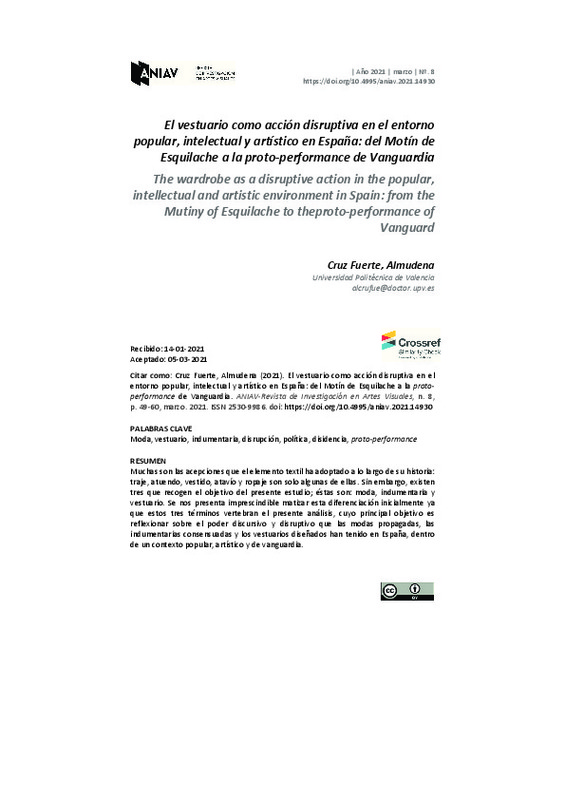|
Resumen:
|
[EN] The textile element has adopted many meanings throughout its history: suit, outfit, dress, attire, clothing, are just some of them. However, there are three that reflect the objective of this study, these are: fashion, ...[+]
[EN] The textile element has adopted many meanings throughout its history: suit, outfit, dress, attire, clothing, are just some of them. However, there are three that reflect the objective of this study, these are: fashion, clothing and costume. It is essential to clarify this differentiation initially, since these three terms build the present analysis, whose main objective is to reflect on the discursive and disruptive power that propagated fashions, consensual clothing and designed costumes have had in Spain, within a popular, artistic and avant‐garde context.Henceforth, we will consider that fashion recreates the game of diffusion of uses, both normative and dissident, of certain garments and accessories; clothing executes assimilation under social consensus, associating meaning with textile signifiers; and finally, the costumes idealize the textile element for artistic purposes.According to this distinction, we have structured a study examining the discursive capacities of the act of dressing, through two interconnected blocks. In the first block, we analyze the disruptive popular actions in which clothing was used, from the Mutiny of Esquilache to the outbreak of the spanish civil war. In the second block, we move the interest to the Spanish art and avant‐garde scene, highlighting those proto‐ performance’s actions where costumes served to emphasize the plastic act, in a period that goes from the first decade of the 20th century to the outbreak of civil strife. Considering civil, political and artistic aspects of the spanish.The study of the civil, political and artistic aspects of the spanish society through the suit, shows us that the clothing regulation and the actions against its compliance are a fascinating starting point to recognize the value that the “act of dressing” has in the philosophical, conceptual and sociological analysis of the world that surrounds us.
[-]
[ES] Muchas son las acepciones que el elemento textil ha adoptado a lo largo de su historia: traje, atuendo, vestido, atavío y ropaje son solo algunas de ellas. Sin embargo, existen tres que recogen el objetivo del presente ...[+]
[ES] Muchas son las acepciones que el elemento textil ha adoptado a lo largo de su historia: traje, atuendo, vestido, atavío y ropaje son solo algunas de ellas. Sin embargo, existen tres que recogen el objetivo del presente estudio; éstas son: moda, indumentaria y vestuario. Se nos presenta imprescindible matizar esta diferenciación inicialmente ya que estos tres términos vertebran el presente análisis, cuyo principal objetivo es reflexionar sobre el poder discursivo y disruptivo que las modas propagadas, las indumentarias consensuadas y los vestuarios diseñados han tenido en España, dentro de un contexto popular, artístico y de vanguardia. Según esto, consideraremos que la moda recrea el juego de difusión de usos, tanto normativos como disidentes, de ciertas prendas y complementos; la indumentaria ejecuta la asimilación bajo el consenso social, asociando significado a significantes textiles; y finalmente, el vestuario idealiza el elemento textil con fines artísticos. Con estas premisas, hemos estructurado un estudio examinando las capacidades discursivas del acto de vestir a través de dos bloques interconectados. En el primero bloque, analizamos las acciones populares disruptivas en las que se utilizó la indumentaria, desde el Motín de Esquilache hasta el estallido de la guerra civil española. En el segundo bloque, trasladamos el interés a la escena artística y de vanguardia española, subrayando aquellas acciones de la proto-performace en la que el vestuario sirvió para enfatizar el acto plástico, en un período que va desde la primera década del siglo XX hasta el estallido de la contienda civil. Este recorrido entorno a la vida civil, política y artística de la sociedad española a través del traje nos demuestra que, tanto la regulación vestimentaria como las acciones en contra de su cumplimiento, son un punto de partida fascinante para reconocer la valía que el “acto de vestir” tiene en el análisis filosófico, conceptual y sociológico del mundo que nos rodea.
[-]
|








